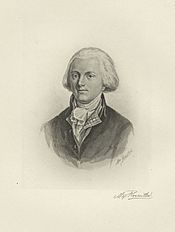Ladd-Gilman House facts for kids
|
Ladd-Gilman House
|
|
|
U.S. Historic district
Contributing property |
|
 |
|
| Location | 1 Governors Lane, Exeter, New Hampshire |
|---|---|
| Built | 1721 |
| Architect | Nathaniel Ladd |
| Part of | Front Street Historic District (ID73000270) |
| NRHP reference No. | 74002055 |
Quick facts for kids Significant dates |
|
| Added to NRHP | December 2, 1974 |
| Designated NHL | December 2, 1974 |
| Designated CP | July 5, 1973 |
The Ladd-Gilman House, also known as Cincinnati Memorial Hall, is a very old and important house in Exeter, New Hampshire, United States. It is listed on the National Register of Historic Places, which means it's a special place worth protecting. It's also a National Historic Landmark, showing its great importance to American history.
Contents
History of the Ladd-Gilman House
When Was the House Built?
The Ladd-Gilman House was built around 1721 by Nathaniel Ladd. It was one of the first houses in New Hampshire made of brick. About 30 years later, wooden boards called clapboards were added to the outside.
The Gilman Family and the Revolution
In 1747, Daniel Gilman, a well-known merchant from Exeter, bought the house. During the American Revolutionary War, this house became very important. It served as the state treasury, where New Hampshire kept its money. Two members of the Gilman family, Colonel Nicholas Gilman and his son John Taylor Gilman, worked as treasurers there. John Taylor Gilman later became the governor of New Hampshire.

Another important person born in this house was Nicholas Gilman, Jr.. He was one of the Founding Fathers, a group of leaders who helped create the United States. Nicholas Gilman, Jr. signed the United States Constitution, which is the main set of laws for the country. He also served as a U.S. senator for New Hampshire.
A National Historic Landmark and Museum
The Ladd-Gilman House was named a National Historic Landmark in 1973. This was mainly because of its connection to Nicholas Gilman, Jr. Since 1902, the house has been cared for by the Society of the Cincinnati. This is an organization that honors officers who served in the Revolutionary War. The Gilman family played a big part in this group.
In 1985, something amazing was found in the house's attic: a Dunlap Broadside. This is one of the very first printed copies of the Declaration of Independence. It was printed on the night of July 4, 1776.
The Ladd-Gilman House and its land are now part of the American Independence Museum. This museum opened in 1991. The famous Dunlap Broadside is the most important item in the museum's collection.
How the House Was Built and Changed
Original Design and Later Additions
The Ladd-Gilman House is a large house made of wood, with a main part and several additions. The main part of the house was first built as a two-story brick building.
After Daniel Gilman bought the house in 1747, his son, Colonel Nathaniel Gilman, made many changes. He removed a wall between two rooms on the right side. He also added a new section with two window bays next to it. To make everything match, he took down the original wall on that side and covered the rest of the house with clapboards.
Another addition was built after the Society of the Cincinnati took over the house in 1902. This part was meant to be a home for a caretaker. Inside the main house, you can still see the original wooden details. These include wall panels, deep window seats, and decorative columns called pilasters.
See also
- Gilman Garrison House
- List of National Historic Landmarks in New Hampshire
- National Register of Historic Places listings in Rockingham County, New Hampshire
- New Hampshire Historical Marker No. 161: Ladd-Gilman House



